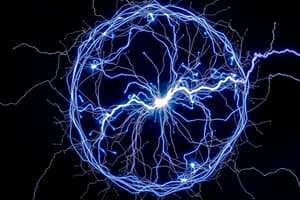Podcast
Questions and Answers
What does Coulomb's law describe?
What does Coulomb's law describe?
- The induction phenomenon in magnetic fields
- The relationship between voltage and resistance
- The behavior of currents in conductive materials
- The electrostatic force between charged particles (correct)
According to Ohm's law, what happens as resistance increases?
According to Ohm's law, what happens as resistance increases?
- Current decreases (correct)
- Resistance decreases
- Voltage decreases
- Charge flow increases
What do changes in a magnetic field generate according to Faraday's law?
What do changes in a magnetic field generate according to Faraday's law?
- Voltage in loops of wire (correct)
- Magnetic fields in conductive materials
- Resistances in circuits
- Electrostatic forces in charged particles
How is resistance calculated according to the relationship in Ohm's law?
How is resistance calculated according to the relationship in Ohm's law?
What physical quantity does Ampere's Law quantify the relation between?
What physical quantity does Ampere's Law quantify the relation between?
Which principle describes the storage of energy as magnetic fields and its rapid dissipation upon removal of the source?
Which principle describes the storage of energy as magnetic fields and its rapid dissipation upon removal of the source?
Flashcards are hidden until you start studying
Study Notes
Electricity and Magnetism: Exploring Interconnected Physical Phenomena
Electricity and magnetism form intertwined branches of classical physics that govern the behaviors of charges and magnetic dipoles at the core of our modern technological societies. They are based upon four fundamental principles, which we'll delve into below.
Coulomb's Law and Electrostatic Forces
Coulomb's law describes the electrostatic force between charged particles—protons and electrons—as well as conductive objects. Positively charged protons repel each other, negatively charged electrons attract positively charged entities, and similarly charged particles avoid close proximity due to mutual repulsion.
Ohm's Law and Resistance
Ohm's law explains how voltage drives electric current through resistances, revealing the relationship among electrical potential difference, charge flow, and resistance (R = V / I). Metals, ceramics, liquids, gases, and semiconductors exhibit differing resistivities depending on their structures and compositions.
Faraday's Law and Inductance
Faraday's law reveals the induction phenomenon, wherein changes in a magnetic field generate voltages in loops of wire. Consequently, inductors store energy as magnetic fields and dissipate energy rapidly upon removal of the source.
Ampere's Law and Magnetic Fields
Ampere's law quantifies the relation between magnetic fields and the surrounding conductive materials. Circulating currents create magnetic lines of forces, which influence each other according to the right hand rule. Permeability constants define the strength of magnetic effects in distinct media.
These principles lead us to develop deep physical understanding about diverse devices and systems such as batteries, capacitors, diodes, transistors, motors, generators, antennas, transformers, and magnets.
Moreover, electricity and magnetism played significant roles throughout history, leading to monumental inventions and scientific discoveries, shaping everything from telegraphy and radio, to computers and renewable energy sources.
Studying That Suits You
Use AI to generate personalized quizzes and flashcards to suit your learning preferences.




